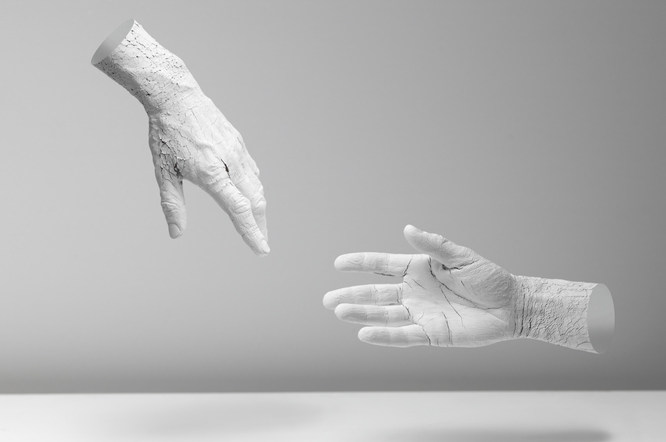I recently came across a hand-made banner unfurled outside an estate on Old Street in East London declaring: “It is only within the context of each other that we are individuals”. It was a powerful reminder of a 21st century paradox: that while we continue to live more connected lives, we feel further apart from each other.

This time last year, Rowan Conway reflected this sentiment writing about how loneliness is a health issue needing a human response. A year on, the issue of loneliness and social isolation has climbed into the popular zeitgeist with books such as ‘The Lonely City’ by Olivia Laing and the BBC One documentary ‘The Age of Loneliness’ linking the rise in single-person households (now numbering 7.7 million), and home-based working, which makes up 10 per cent of the working-age workforce, with increased loneliness.
We are still only just understanding the implications of widespread loneliness that characterises modern living. What we do know however, is that the impact of loneliness on the NHS is already stark. At a time of acute service pressure, understanding how to measure the problem and who is most affected, is critical when designing responses to it.
What affect does loneliness have on our health?
Neuroscientist John Cacioppo’s seminal work published in ‘Loneliness: Human Nature and Need for Social Connection’ was one of the first to study the health impacts of loneliness. He found that lonely people have a 20 per cent higher premature mortality rate and called for a culture shift that would see loneliness as important a public health issue as obesity. The Campaign to End Loneliness acknowledges this; reporting that 3 out of 4 GPs say they see between 1 and 5 people a day who have come in mainly because they are lonely.
Indeed, research tells us that this phenomenon goes far beyond the familiar stereotype of an isolated grandmother. A recent British Red Cross report found that 32 per cent of those aged 16-24 reported that in the past 2 weeks they had often or always felt lonely. Are 1/3 of young people just snowflakes? It seems unlikely.
This has contributed to pressure for government to respond. But how do we measure the problem and what are responses required to tackle it?
Who's lonely and how do we measure it?
Loneliness is a universal and largely episodic experience but one that is inherently subjective. So whilst there are two well used measurements - the UCLA loneliness scale and the De Jong Gierveld loneliness scale - it still becomes difficult to define when exactly someone is or is not experiencing loneliness.
There is a consensus emerging on a definition however - one that defines loneliness as the gap between someone’s desire for connection and the reality of their connections. This makes intuitive sense; an Italian grandmother who receives visits from their grandchildren and family twice a day may be equally as lonely as her Swedish counterpart that sees her family only once a year.
Being lonely is almost by definition an individual experience, but we know that particular groups in society can be more vulnerable to experiencing loneliness. For instance, the highest prevalence of loneliness seems to come from carers, with 80 per cent reporting that they often feel or are lonely.
Amongst disabled people, half of disabled people feel lonely ‘often’ or ‘very often’ and 58 per cent of refugees and migrants in London describe loneliness and social isolation as their biggest challenge.
How do we respond?
Loneliness is a social, collective challenge that we need to face, but one that the NHS currently bears the brunt of.
When it comes to the response, it’s important to recognise that much of the cost falls on general practice. GPs train for a minimum of seven years in medicine, yet many report spending almost a fifth (19 per cent) of their time on social issues that are not principally about illness. While 80 per cent of GPs report that this helps them understand the community and the social determinants of illness, this is clearly an area that collaborating with the voluntary sector as well as investing in social infrastructure will help lift the pressure on GP workload.
We’ve seen first-hand some of the community responses to this problem. The RSA has been working with the ‘anti-loneliness league’ in Stockport, Oldham and Tameside as part of the Health as a Social Movement programme. Funded by small grant ‘sparks funding’ through NHS New Care Model site Stockport Together, it has been able to bring together groups of young people with learning disabilities and older people through art, helping to reduce social isolation across the three boroughs and principally, provide respite to carers.
The Jo Cox Commission and a wealth of partners are reframing the debate and demanding significant resources to scale up responses to the challenge. Building a community where no-one is lonely is likely impossible, but the harshest effects of isolation can definitely be ameliorated more consistently and earlier. The fact that, for instance, nearly half of those aged 65+ say that television or pets are their main form of company should be a sobering call to action.
The NHS has an uphill struggle in combating this but focusing on interventions that acknowledge the diverse groups most suseptible to loneliness, as well as following the successes of projects like Stockport Together and the RSA’s Connected Communities programme, is a good start.
Until we reach towards a societal goal that is sufficiently ambitious we are likely to still rely on services to tackle an issue of huge national and political concern. As the banner brazenly points out, we all benefit from making time for connection. In fact, our health service depends on it.
Find out more about the Health as a Social Movement programme and the ‘anti-loneliness league’ in Stockport by contacting Carey Bamber at careybamber@live.com
Follow the author on twitter @_Tom_Harrison
Related articles
-
A social justice cause for the 2020s – reining in health spending
Anthony Painter
Anthony Painter argues that the state expansionists will win over small statists as healthcare expenditure is destined to increase. But their victory may be a Pyrrhic one unless the growth can be limited so better support can also be given to housing, economic security, education and lifelong learning.
-
Did Bevan's bedpan test set the NHS on the wrong track?
Ed Cox
Ed Cox, Director of Public Services and Communities, argues that the NHS needs a more devolved approach in the decade ahead.
-
8 principles for future health and care systems
Tom Harrison
The RSA and NEF in partnership with NHS England publish eight principles to develop a community-led health system.




Join the discussion
Comments
Please login to post a comment or reply
Don't have an account? Click here to register.
Really important and interesting topic, especially with the growing self-employed economy who may sense isolation as a result. How can we build a culture where it is more acceptable to chat or connect with relative strangers? At the moment, if one strikes up conversation on the bus or tube, it is regarded with suspicion... or is it?